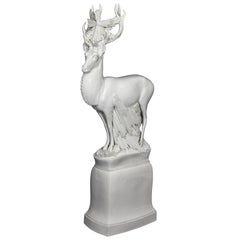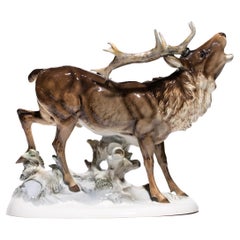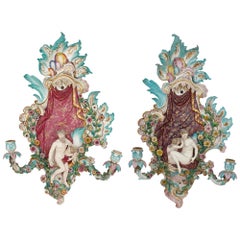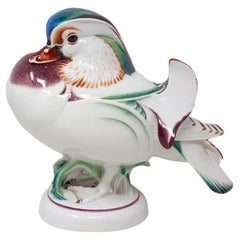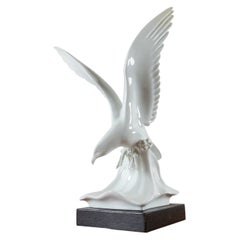Max Esser Furniture
to
1
1
1
1
1
1
1
1
1
1
1
1
1
1
1
11,957
3,896
2,419
2,231
Creator: Max Esser
A Monumental Max Esser Meissen Porcelain Blanc de Chine Model of a Stag (Deer)
By Max Esser, Meissen Porcelain
Located in New York, NY
A Monumental and Very Rare Blanc de Chine Porcelain Model of a Stag (Deer) by Max Esser, Produced by the Meissen Porcelain Manufactory During the P...
Category
1920s German Art Deco Vintage Max Esser Furniture
Materials
Porcelain
$59,880 Sale Price
20% Off
Related Items
Hutschenreuther Selb Porcelain Figurine "STAG DEER"
By Hutschenreuther
Located in Bloomfield Hills, MI
The Stag Deer porcelain has been manufactured by the Hutschenreuther - Selb - Kunstabteilung (art studio). The underside bears the authentic marks of the Hutschenreuther-Selb company...
Category
1950s German Vintage Max Esser Furniture
Materials
Porcelain, Paint
Pair of Antique Porcelain Sconces by Meissen
By Meissen Porcelain
Located in London, GB
Pair of antique porcelain sconces by Meissen
German, late 19th Century
Measures: Height 57cm, width 38cm, depth 10cm
This fine pair of Ge...
Category
Late 19th Century German Rococo Antique Max Esser Furniture
Materials
Porcelain
$16,887 Sale Price / set
30% Off
H 22.45 in W 14.97 in D 3.94 in
Chinese Blanc de Chine Porcelain Quan Yin
Located in Delray Beach, FL
Chinese tall Blanc de chine standing Quan Yin dressed in a flowing robe, the base is decorated with lotus flowers and pads. Marked China in the bottom.
Category
1960s Chinese Vintage Max Esser Furniture
Materials
Porcelain
Fine Large Late 18th - Early 19th Century Meissen Porcelain Model of a Swan
By Meissen Porcelain
Located in New York, NY
A fine, exceptionally detailed large Meissen model of a swan, modelled by J. J. Kändler, with incised plumage, the feathers of the wings picked out in soft grey and beige, with russe...
Category
Late 18th Century German Neoclassical Antique Max Esser Furniture
Materials
Porcelain
$9,500
H 14.25 in W 9.25 in D 13.5 in
Meissen Hand Painted Porcelain Plate
By Meissen Porcelain
Located in Vilnius, LT
Meissen porcelain plate in relief decor and hand painted in gold.
Category
Mid-20th Century German Max Esser Furniture
Materials
Porcelain
Unique and Monumental Late 19th Century German Meissen Porcelain Mirror
By Meissen Porcelain
Located in Long Island City, NY
A Unique and Monumental Late 19th Century German Meissen Porcelain Mirror
This palatial mirror is made up of around 12 wonderful individually hand c...
Category
Late 19th Century German Belle Époque Antique Max Esser Furniture
Materials
Glass, Porcelain
$257,500
H 105 in W 58 in D 5 in
19th century German Meissen painted porcelain model of a Pigeon
By Meissen Porcelain
Located in Dublin, IE
A very colorful and attractive 19th century Meissen painted porcelain model of a Pigeon, with feathered feet, on rocky base, with unglazed blue crossed swords mark to base.
Circa 18...
Category
19th Century German Rococo Antique Max Esser Furniture
Materials
Porcelain
Antique Meissen Porcelain Cherub Motto Figurine "Je decouvre tout" Model F13
By Michel Victor Acier 1, Meissen Porcelain
Located in Philadelphia, PA
A fine antique porcelain Cupid figurine.
By Meissen.
Model no. F13 from the Cupid Motto Series.
Entitled "Je decouvre tout".
Originally de...
Category
Early 20th Century German Rococo Max Esser Furniture
Materials
Porcelain
$1,080 Sale Price
20% Off
H 5.25 in W 3.25 in D 2.75 in
A Monumental Meissen Porcelain Figural Group of Mount Parnassus
By Meissen Porcelain
Located in Brighton, West Sussex
A Monumental Meissen Porcelain Figural Group of Apollo and the Nine Muses on Mount Parnassus.
Comprised of sixteen interlocking parts. Apollo standing holding a lyre and with Pegasus besides a tree, atop a rocky outcrop detailed with foliage and waterfalls above nine goddesses:
Calliope, seated and shown writing, representing eloquence and epic poetry.
Clio, seated with an open book and blowing a trumpet, representing history.
Erato, seated and holding a kithara, representing science and the arts
Euterpe, seated and holding a flute, representing music.
Melpomene, seated holding a knife and with one hand to her head, representing tragedy.
Thalia, seated and holding aloft mask, representing comedy and idyllic poetry.
Urania, seated with telescope and globe, representing astronomy and astrology,
Polyhymnia, standing with one hand raised and holding a book, representing sacred poetry.
Terpsichore, standing, representing dance.
Each piece exceptionally finely detailed and painted. The base portions with rocaille edges. On a later black polished wooden base.
Multiple blue crossed swords marks. Each piece titled to underside.
German, Circa 1880.
Mount Parnassus, is a spur of the Pindus Mountains in central Greece and was sacred to the ancient Greeks and in mythology to Apollo, the god of music and poetry and of the Sun and light. Mount Parnassus the mythical centre of poetry, music, and learning in ancient Greece was a popular theme in Barqoue and Rococo art, often substitutable with Athena’s arrival at Mount Helicon from the fifth book of Ovid’s “Metamorphoses”, where she asks the Muses to show her the new spring which gushed forth from the spot where Pegasus “with his hoof of horn opened the earth” (V, 250-260).
Here, the mountain, formed from rugged rock cliffs, culminates in a plateau on which the youthful Apollo stands and plays the lyre. The Castalian spring flows from beneath Pegasus’ hoof, representing the source of inspiration and attracting the nine muses, who embody the arts and inspire creation through song, music, and dance.
Mount Parnassus was created at the Meissen porcelain manufactory as a table centrepiece and an earlier version, apparently with only five muses, is listed in the inventory of the pastry shop of the Meissen manufactory manager and cabinet minister Heinrich Graf Brühl in 1753. The storage in the pastry shop of approximately 3,000 objects and dishes, including many individual parts for centrepieces, is related to their function as table decorations, replacing decorations previously made by the confectioner from perishable materials such as sugar or wax.
The purpose of this table decoration was as a feast for the eyes to accompany the feast of the banquet. The sculptural figurines often depicted a particular theme, with characters drawn from theatre and opera, from classical mythology or pastoral idylls. Allegories and mythological themes, such as the glorification of fine arts, were also popular. Stylistically, Mount Parnassus fits Kändler’s style of the 1740s, and was sold by Brühl in 1762 to Frederick the Great of Prussia who used mythology as a means of self-expression and had already ordered individual figures of Apollo and the Muses as table decorations in 1744. Today it is in the Museum of Applied Arts, Frankfurt (inv. no. M.L. 41). There is another version of Mount Parnassus, from the collection of Prince Alexander Dolgorukoff, in the Hermitage in Saint Petersburg.
The present version dates to the second half of the nineteenth century when there was a great revival of Kändler rococo figurines which were reissued and a “Second Rococo”. Another nineteenth century example is in the collection of the Museo Francesco Borgogna, Italy (inv. 1906, XIII, 19-20). These nineteenth century versions were made by the Meissen factory using Kändler's period models. It is recorded that a new version of Mount Parnassus, dating to the 1880s, was part of the Royal Porcelain collection in Dresden:
'In the porcelain collection there is a new version from the 1880s based on the old models, the largest group of this genre, the Parnassus, which shows the named muses all around on the lower part of the rock, each practising their own art, while on the top there is Apollo with the lyre and next to it the Castalian spring rises from the hoofbeat of Pegasus. Each figure is executed individually with its rocky background, and all the pieces are then fitted together, as we have already seen in his earlier, larger compositions. The rock pieces are finished off like a pedestal at the bottom with Rococo ornaments.' (Jean Louis Sponsel, Kabinettstücke der Meissner Porzellan-manufaktur von Johann Joachim Kändler, Leipzig, 1900, pp. 203-204).
Kunst und kunsthandwerk; monatsschrift herausgegeben vom Österreichischen museum fuer kunst und industrie, Vienna, 1894, v.7 pt.1, p.133.
Kari Berling, Das Meißner Porzellan und seine Geschichte. Leipzig 1900, S. 99, 187-200.
Helmuth Gröger, Johann Joachim Kaendler. Dresden, 1956.
Peter W Meister, Franz Adrian Dreier, Figürliche Keramik aus zwei Jahrtausenden. Kat Museum für Kunsthandwerk, Frankfurt. Frankfurt 1964, Nr. 90.
Rainer Rückert, Meißener Porzellan, 1710-1810. Kat. Ausst. Bayerisches Nationalmuseum München. München 1966.
Stefan Bursche, Tafelzier des Barock. München 1974, Abb. 300.
"Tafelaufsatz, Der Parnass", Auswahlkatalog, Museum für Kunsthandwerk (Frankfurt am Main, Germany), 1987, pp. 86-87.
Alfred Ziffer, ‘Meissener Porzellanplastik für fürstliches Interieur und Zeremoniell’, Keramos, Issue 241/242, pp. 29–52.
MEISSEN
The production of Meissen porcelain began in 1710 at the manufactory at Meissen...
Category
19th Century German Rococo Antique Max Esser Furniture
Materials
Porcelain
$261,360
H 26.78 in W 36.23 in D 24.02 in
Antique Japanese Blanc de Chine Buddha
Located in Lambertville, NJ
A blanc de chine porcelain figure of the Buddha, Japanese, Kutani, circa 1900.
Category
Early 1900s Japanese Meiji Antique Max Esser Furniture
Materials
Porcelain
19th Century Meissen Model of a Slipper
By Meissen Porcelain
Located in West Palm Beach, FL
19th Century Meissen Model of a Slipper
Delve into the high Victorian era with this enchanting 19th century Meissen model of a slipper. Crafted by the illustrious Meissen Porcelain, this artifact embodies the elegance of its time with intricate designs and detailed hand painting. The porcelain slipper...
Category
Late 19th Century German High Victorian Antique Max Esser Furniture
Materials
Porcelain
Meissen Porcelain Monkey Musician Figurine
By Meissen Porcelain
Located in New York, NY
Meissen Porcelain Monkey Musician Figurine. The Meissen porcelain figurine represents a violinist monkey from the celebrated “Monkey Band” ser...
Category
20th Century German Rococo Max Esser Furniture
Materials
Porcelain
Previously Available Items
Meissen Mandarin Duck Max Esser Art Deco
By Meissen Porcelain, Max Esser
Located in Newark, England
Chinese Mandarin Duck
From our Ceramics collection, we are delighted to offer this Meissen Mandarin Duck Modelled by Max Esser. The Meissen Mandarin Duck beautifully sculpted in nat...
Category
Early 20th Century German Art Deco Max Esser Furniture
Materials
Porcelain
Vintage Porcelain Seagull Figurine by Max Esser for Meissen, 1930s
By Meissen Porcelain, Max Esser
Located in Asaa, DK
Vintage porcelain bird figurine by Max Esser for Meissen, 1930s
German figurine in white porcelain mounted on a black wooden base depicting a seagull spread...
Category
1930s German Art Nouveau Vintage Max Esser Furniture
Materials
Porcelain
Meissen Animal Figurine, Lovely Gyrfalcon, Max Esser, 20th Century
By Max Esser
Located in Vienna, AT
Meissen Gorgeous Animal Figurine Gyrfalcon (made 20th century)
MEASURES / DIMENSIONS:
height: 20.5 cm ( = 8.070 inches )
diameter of base: 6.5 cm ( = 2.55 inches )
Manufactory: Meissen
Hallmarked: Blue Meissen Sword Mark (underglazed)
FIRST QUALITY
MODEL NUMBER 77378 ( = vintage model number H 235 )
FORMER'S NUMBER 258 PAINTER'S NUMBER 23
Dating: 20th century (made 1991 / year's mark existing)
Material: porcelain, glossy finish, multicolored painted
Technique: handmade porcelain
Style: Art Deco, designed by Max ESSER...
Category
Late 20th Century German Art Deco Max Esser Furniture
Materials
Porcelain
Meissen Art Deco Centrepiece Bowl Monkey and Cockatoo by Max Esser made 1924-34
By Max Esser
Located in Vienna, AT
Meissen Art Deco Tall Centrepiece:
Large Bowl with Monkey and Cockatoo
created by Max Esser (1885 - 1945), modelled 1922
Hallmarked:
Meissen Cros...
Category
1930s German Vintage Max Esser Furniture
Materials
Porcelain
Max Esser furniture for sale on 1stDibs.
Max Esser furniture are available for sale on 1stDibs. These distinctive items are frequently made of porcelain and are designed with extraordinary care. There are many options to choose from in our collection of Max Esser furniture, although gray editions of this piece are particularly popular. Many of the original furniture by Max Esser were created in the Art Nouveau style in germany during the 1930s. If you’re looking for additional options, many customers also consider furniture by Carstens Tönnieshof, Otto Keramik, and Erwin Eisch. Prices for Max Esser furniture can differ depending upon size, time period and other attributes — on 1stDibs, these items begin at $667 and can go as high as $667, while a piece like these, on average, fetch $667.
